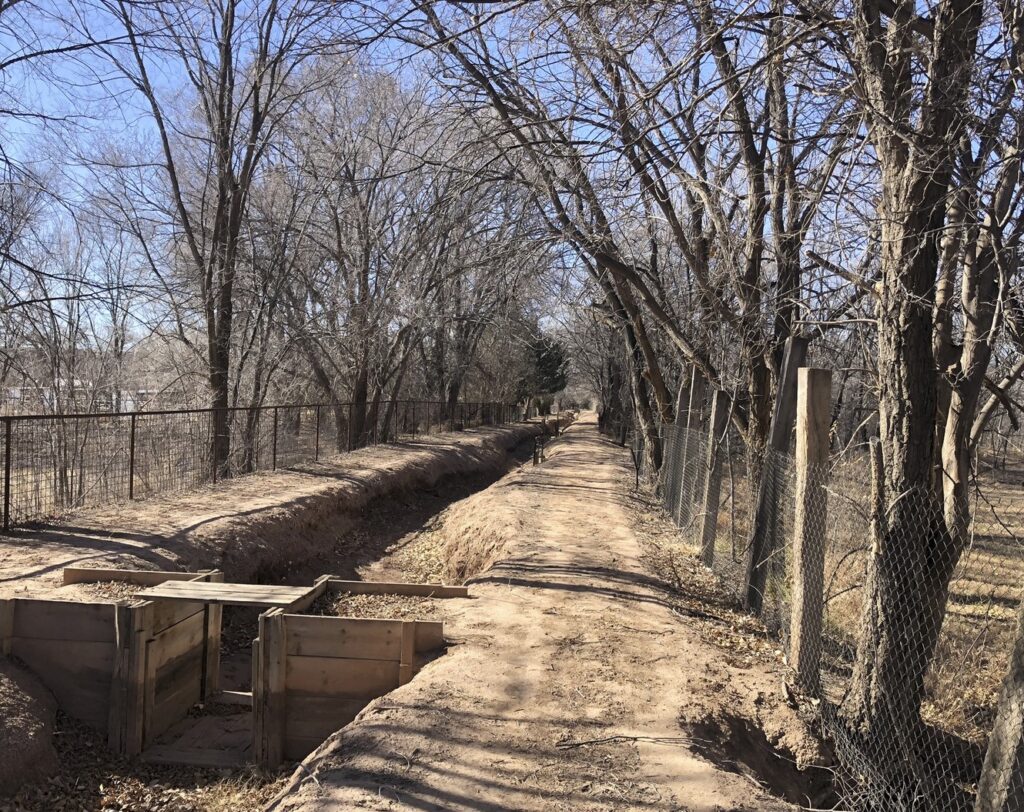
The Duranes, in Albuquerque’s North Valley, awaits first water. February 2023
The Middle Rio Grand Conservancy District began diverting water this morning (March 16, 2023) around 4 a.m. from the Angostura Diversion Dam north of town into the Albuquerque Main. The big concrete-lined channel carries water down the east side of the river some 15 miles to Albuquerque’s North Valley.
It irrigates land along the way in Santa Ana and Sandia Pueblos, two Native American communities that have lived and farmed their lands for what we call “time immemorial”, a poetic term rooted in English common law that the English jurist William Blackstone in the 1700s described as “a time whereof the memory of man runneth not to the contrary.”
By next week, the water will be flowing down through the city, through a hybrid landscape that is sorta “peri-urban”, a term that’s usually used to describe the transition zone between urban and rural areas. But Albuquerque’s peri-urban landscape is weird, or at least we think it’s weird (a central theme in our new book).
Peri-urban landscapes are often characterized by the tension of a city sweeping away the rural, an expanding series of concentric circles as the urban area pushes outward. But in Albuquerque the ditches of the Middle Rio Grande Conservancy District instead became a peri-urban anchor that preserved a belt of quasi-rural green run straight through the city’s urban core.
The economics wonks have a conceptual framework to think about what has happened here in the notion of “non-market values”. We normally think of irrigation ditches as conveying economic benefit via crops that farmers sell. Here, the value is non-market:
- a preservation of a perceived cultural and historical significance, maybe growing a bit of hay or some fruit trees (I say “perceived” – maybe not quite the right word? – because our narrative of the history of agriculture in the valley doesn’t seem to match up well with the actual history, but the non-market value comes from the perception, eh?)
- ecosystem services – the richly understudied biodiversity of the ditch network is endlessly fascinating, a novel ecosystem that’s been around for hundreds of years
- recreational opportunities – walking, biking, fishing. Yeah, really, people fish the ditches!
- community cohesion – social capital is built around the shared experiences of a neighborhood ditch
- aesthetic values – have y’all seen that giant cottonwood along the Griegos Lateral?
My book’s co-author, Bob Berrens, and I are playing with an intriguing hypothetical: What would it take to add something like this to a city after the fact? Like, take a modern western city that’s kinda dry and boring and add a network of public flowing water through its midst, with trees and walking trails in the cool summer shade?
You couldn’t do it.
Years ago I was out on a newspaper story around this time of year with the late Joey Trujillo, the MRGCD guy in charge of helping usher the water down the Albuquerque Main into the city. I can’t find the old quote, so I’m doing this from memory, which is risky, but what I remember Joey saying is this:
I love this time of year. You can feel the valley breathing in.

Love ‘The Valley breathing in’. !!
Thanks for these newsletters.
I absolutely believe these non-market values and that in a perfect world they would be important drivers of policymaking.
However, in that perfect world, policymakers would also want to have as many people as practicable have easy access to the portion of these non-market values that are increased by proximity. For example, people who can easily walk *to* the ditches are much more likely to walk along the ditches more often and derive the non-market experience value from that.
The implication of that would be for policymakers to upzone the areas near the ditches, near the bosque, etc. to allow lots of apartments to be built there and thus many more people to derive more of these non-market values.
The fact that that hasn’t occurred leads me to deduce that the dominant political factor leading to policies preserving the ditches, the low-cost residential groundwater pumping, etc. is regulatory capture by (mostly wealthy) local residents in the North Valley. NOT benevolent policymaking that truly weighs these non-market values.
Well put, Alex, that nails the issue in a really clear and helpful way, thanks.
The timeless quality of the acequias is captivating. Add to that the even older and very successful ways in which Indian people retained rainwater in ancient times. When I lived in NM, I often lived in the valley and saw ditches abandoned in the 1950s due to post-WWII new subdivisions, and very overgrown ditches used by just a few often elderly folks. Even the promise of large work crews who moved through the ditches each spring, clearing and restoring as they went, was no longer the norm. The elm trees moved in, the ditches were eroded….water flowed less and less. Yet the promise of water for fields and orchards always stirs us. Thanks for exploring all this in your new book.
I absolutely love the quote about feeling the Valley breathing in this time of year! If you listen really closely you can hear a satisfied exhale as well.
Thank you John Fleck!
Would recommend looking at the river park in Beersheba, Israel. An interesting case of someone actually doing this in a water-scarce region. Totally different regime of water law, but an interesting case!